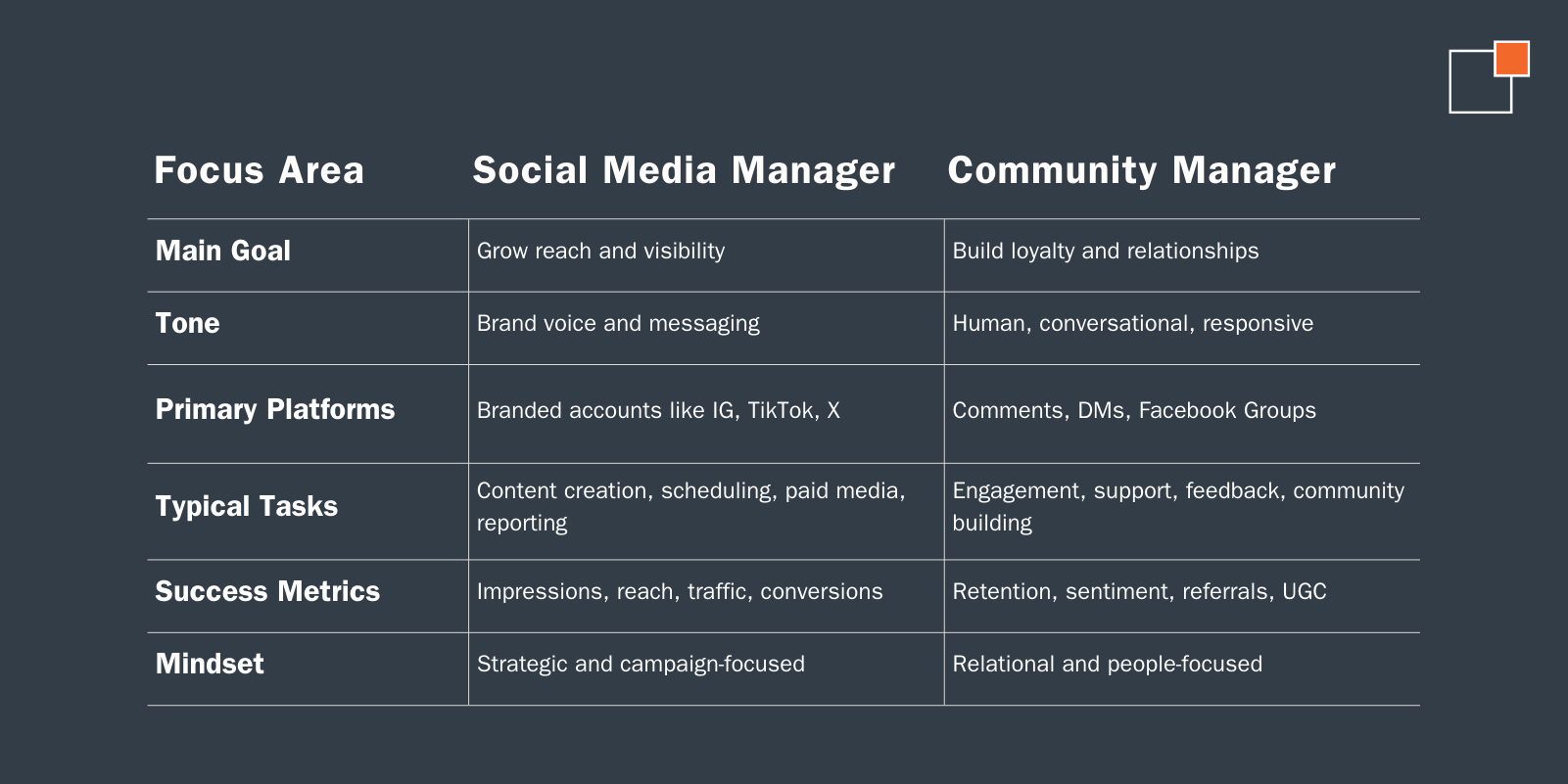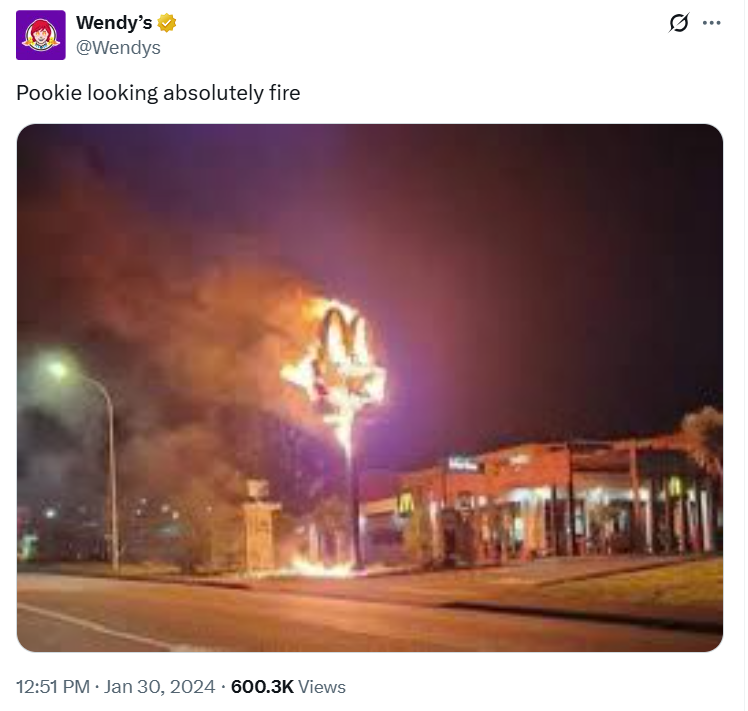Community Manager vs. Social Media Manager:
What’s the Difference and Which One Does Your Brand Need?
The titles "Community Manager" and "Social Media Manager" often get mixed up. On the surface, they seem similar. Both roles show up online, interact with followers and help build a brand’s presence across social platforms. In many companies, one person may even juggle both.
Think of it like this: a Social Media Manager plans the wedding. A Community Manager makes sure your aunt doesn’t start drama at Table 9. These roles aren’t the same. Though complementary, each play a specific part in how a brand connects with its audience and grows over time.
Knowing the difference helps you build stronger strategies and avoid hiring missteps. So let’s take a moment to get clear on what each role actually does, how they support different goals and why it’s important to treat them as distinct.

They focus on the big picture, making sure your brand shows up consistently across platforms like Instagram, TikTok, LinkedIn, Facebook and X. That includes writing captions, planning campaigns, scheduling posts and tracking what’s working.
Typical responsibilities:
Engagement might be part of the role, but their primary focus is broadcasting. They’re focusing on reach, impressions and clicks more than responding to comments or engaging in one-on-one conversations.
Typical responsibilities:
The difference comes down to focus. Social Media Managers care about reach and content performance. Community Managers care about conversation and connection. One is posting to the crowd. The other is in the crowd, talking to people and making sure they stick around.
Look at Wendy’s on X. Wendy’s doesn’t just post content—they interact like a real person. Take this viral tweet, where they quote a photo of a burning McDonald’s sign with “Pookie looking absolutely fire.” It’s timely, unhinged and exactly what their audience loves.
Not every team has the budget or resources to hire for both roles right away. In the early stages, one person may take on both roles, which is perfectly fine. However, as your brand grows, splitting these roles can elevate your strategy and strengthen your connection with your audience.
Here’s a quick guide to help you decide:
By now, the differences between these two roles are probably clear. But it helps to see them side by side. Here’s a quick breakdown:

Social Media Managers and Community Managers might work in the same space, but they’re doing very different jobs. One builds the brand; the other builds the relationship.
If you treat these roles as the same, you risk missing opportunities on both sides. But when you understand how they complement each other, you can create stronger strategies, deeper connections and a better overall experience for your audience.
Whether you're hiring or refining your strategy, knowing the difference helps you focus your time and resources in the right place.
Not sure where to start? thunder::tech has social media experts ready to help you craft the right strategy and connect with your audience in a way that actually works. Let’s talk!

Think of it like this: a Social Media Manager plans the wedding. A Community Manager makes sure your aunt doesn’t start drama at Table 9. These roles aren’t the same. Though complementary, each play a specific part in how a brand connects with its audience and grows over time.
Knowing the difference helps you build stronger strategies and avoid hiring missteps. So let’s take a moment to get clear on what each role actually does, how they support different goals and why it’s important to treat them as distinct.

What is a social media manager?
A Social Media Manager is the person behind your brand’s public-facing content. They’re responsible for what gets posted, when it goes out and why it matters. Their main goal is to grow your audience, increase brand awareness and drive traffic through strategic content.They focus on the big picture, making sure your brand shows up consistently across platforms like Instagram, TikTok, LinkedIn, Facebook and X. That includes writing captions, planning campaigns, scheduling posts and tracking what’s working.
Typical responsibilities:
- Managing the content calendar
- Writing captions and producing or sourcing visuals
- Scheduling and publishing posts
- Watching trends and keeping the brand voice consistent
- Reviewing analytics and adjusting the strategy
- Supporting paid campaigns
Engagement might be part of the role, but their primary focus is broadcasting. They’re focusing on reach, impressions and clicks more than responding to comments or engaging in one-on-one conversations.
What is a community manager?
A Community Manager focuses on people, not just posts. Their job is to build relationships, create a sense of belonging and turn casual followers into loyal fans. While the Social Media Manager sets the tone for the brand, the Community Manager keeps the conversation going.Typical responsibilities:
- Responding to comments and DMs
- Starting and moderating conversations in online communities
- Managing groups or forums
- Encouraging user-generated content and brand advocacy
- Organizing meetups, virtual events or community spotlights
- Gathering feedback and passing insights back to the team

Where the confusion comes from
It’s easy to see why these roles get mixed up. They use a lot of the same tools. Social and community managers often share dashboards, calendars and scheduling platforms. From the outside, it can look like they’re doing the same thing.The difference comes down to focus. Social Media Managers care about reach and content performance. Community Managers care about conversation and connection. One is posting to the crowd. The other is in the crowd, talking to people and making sure they stick around.
Look at Wendy’s on X. Wendy’s doesn’t just post content—they interact like a real person. Take this viral tweet, where they quote a photo of a burning McDonald’s sign with “Pookie looking absolutely fire.” It’s timely, unhinged and exactly what their audience loves.
They tap into internet culture in a way that feels human. They can speak to trends because they act like part of the platform, not just a brand using it. That means using the same tone, references and timing as real people, not polished, delayed brand statements. It’s subtle, but that’s the difference strong community management makes.
Most brands focus on what they want to say. Community managers, like the one behind Wendy’s, know how to listen, join conversations in real-time and match the tone of their audience. That’s why the tweet landed.
The tweet went viral not because it followed a content calendar, but because it responded to the moment and the kind of humor Wendy’s fans expect. It’s bold, culture-focused and perfectly in sync with the brand’s personality. That’s what keeps people coming back—not just to buy a burger, but to see what Wendy’s will say next.
Most brands focus on what they want to say. Community managers, like the one behind Wendy’s, know how to listen, join conversations in real-time and match the tone of their audience. That’s why the tweet landed.
The tweet went viral not because it followed a content calendar, but because it responded to the moment and the kind of humor Wendy’s fans expect. It’s bold, culture-focused and perfectly in sync with the brand’s personality. That’s what keeps people coming back—not just to buy a burger, but to see what Wendy’s will say next.
When you need one vs both
Not every team has the budget or resources to hire for both roles right away. In the early stages, one person may take on both roles, which is perfectly fine. However, as your brand grows, splitting these roles can elevate your strategy and strengthen your connection with your audience.
Here’s a quick guide to help you decide:
Start with a Social Media Manager if you:
- Need help growing brand awareness
- Focus on content, paid ads or platform strategy
- Want to drive traffic to a site, product or campaign
Prioritize a Community Manager if you:
- Already have an active audience
- Get lots of comments, questions or UGC
- Want to strengthen brand loyalty or support
Hire both when you:
- Need to manage multiple platforms and communities
- Want to grow your reach and deepen engagement
- Find one-on-one engagement hard to scale because of audience size
By now, the differences between these two roles are probably clear. But it helps to see them side by side. Here’s a quick breakdown:

Social Media Managers and Community Managers might work in the same space, but they’re doing very different jobs. One builds the brand; the other builds the relationship.
If you treat these roles as the same, you risk missing opportunities on both sides. But when you understand how they complement each other, you can create stronger strategies, deeper connections and a better overall experience for your audience.
Whether you're hiring or refining your strategy, knowing the difference helps you focus your time and resources in the right place.
Not sure where to start? thunder::tech has social media experts ready to help you craft the right strategy and connect with your audience in a way that actually works. Let’s talk!

About the Author
Gabriella Caldwell is a Digital Marketing Strategist at thunder::tech. Outside of the office she can be found in a ceramics studio sculpting away, or visiting local art galleries.
